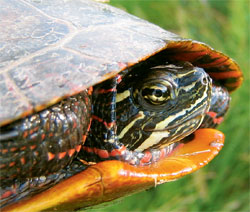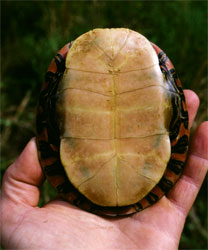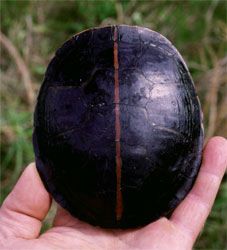The painted turtle (Chrysemys picta) is perhaps one of the most attractive turtles in North America.
 |
The painted turtle is perhaps one of the most attractive turtles in North America. It is also one of the most widespread and abundant, making it a common species budding herpetologists and herpetoculturists encounter in their childhood years. For those of us who grew up in the Northeast, a painted turtle sighting in early March was a certain sign that spring was finally on its way.
When I was a child, my father gave me a leaky, old wooden rowboat. Armed with a life jacket and a dip net, I spent many summer days honing my rowing skills and sneaking up on the basking painted turtles that were abundant in a small lake in our northern New Jersey neighborhood.
I’d catch a dozen or more and have them crawling about in the boat around my feet. At the end of each expedition, I’d let them all go, sometimes bringing a small, exceptionally colorful one home to keep in a play pool in the backyard. After a short period of time, I brought it back to the lake. Turtles in general helped me develop an appreciation of nature and formulate my own childhood understanding of how animals interacted with their environment.
I specifically remember one spring when steam shovels dredged the shallow end of the lake, where the painted turtles were most abundant, in order to make a boat dock and “clean up all the weeds.” Part of the “improvement” project included rip-rapping the edges of the lake with stone. Although you could still see some painted turtles basking on those rocks for some years, after that their abundance declined.
While attending summer camp, I spent time boating on that facility’s glacial lake looking for painted turtles. I remember the lifeguards yelling at me to get my boat out of the lily pads, where the turtles were, and stay in the boring open water of the lake.
Years later, when I was in college and became the waterfront director at that same summer camp, that rule was changed. In fact, we started a mark-recapture project on the resident painted turtles that continues today.
 Eastern painted turtles (C. p. picta) occur from northern Georgia up the Eastern Seaboard into New Brunswick and Nova Scotia in Canada. Photograph by Kurt A. Buhlmann |
Distribution And Subspecies
Occurring throughout the United States, the painted turtle (Chrysemys picta) is the only turtle species that spans coast to coast in its natural range. Of the 48 continental states, the painted turtle occurs in 45 of them. It is really only naturally absent from a few states notable for herpetological biodiversity, specifically Florida, California and Nevada. It also inhabits eight Canadian provinces bordering the United States, stretching from Nova Scotia to British Columbia. The painted turtle also occurs in the state of Chihuahua in Mexico.
Scientists recognize four subspecies of painted turtle. Although there is little reproductive isolation between the subspecies today, during the last period of glacial advance, three isolated refugia may have existed: in the Southwest, lower Mississippi Delta and Southeast. As the glaciers retreated and these populations moved northward, they came into contact in some geographical regions and interbred again.
Southern painted turtle
The southern painted turtle (C. p. dorsalis) is the smallest race. Rarely attaining a carapace length of more than 5 inches, it has a unique and distinctive red stripe on the center of the carapace that extends the length of the shell. Its head markings include yellow stripes that are somewhat jagged or wavy. The southern painted turtle occurs primarily in the Mississippi and Gulf Coast drainages of Louisiana, north through Arkansas and into southeast Missouri, as well as Mississippi, Alabama and western Tennessee.
Eastern painted turtle
The eastern painted turtle (C. p. picta) is the next smallest (up to 6 inches in carapace length). The yellow markings on the head often form distinct spots in this subspecies, and the plastron is immaculate yellow. The eastern painted turtle can be found from northern Georgia through western South Carolina and northward through Virginia, eastern Pennsylvania, New Jersey and New England, to New Brunswick and Nova Scotia. It generally occurs east of the Appalachian mountain divide, though it intergrades with the midland painted turtle throughout much of Pennsylvania and areas of New England. It is absent from the Coastal Plain in the southeastern United States, perhaps as a result of the occurrence of alligators and competition with yellowbelly sliders (Trachemys scripta scripta), a larger and ecologically similar cousin.
Midland painted turtle
The midland painted turtle (C. p. marginata) is similar to the eastern form in size, though it displays a faded red and black plastral marking, and the yellow head markings exist as parallel stripes. Midland painted turtles occur in the Tennessee River drainages, the upper Mississippi drainage, throughout the Great Lakes region, Ontario and east to New York, Quebec and the St. Lawrence drainage. Midland painted turtles also intergrade with western painted turtles in upper Michigan and Wisconsin.
Western painted turtle
Western painted turtles (C. p. bellii) are the largest subspecies, attaining carapace lengths of 7 to 8 inches. The carapace markings tend to be less prominent than those in other subspecies; however, the plastron has a vibrant black and red central pattern. The yellow head stripes are parallel. Western painted turtles are found from the Great Lakes west through the upper and middle Great Plains, extending into southern Saskatchewan and Alberta and south to Kansas and eastern Colorado. They reach the Pacific in British Columbia and Washington. Isolated southwestern populations occur in the flood plain wetlands of the Pecos River and the Rio Grande in New Mexico and Mexico.
Painted Habitats
The painted turtle is a habitat generalist, meaning it occurs in a variety of habitat types. In my experience, favorite haunts inhabited by reproducing populations include shallow ponds covered in lily pads or marshes covered in duckweed. However, painted turtles are found in the slower stretches of streams. They can be abundant along the edges of large lakes, reservoirs and even rivers provided that there are ample basking sites, such as downed trees and exposed rocks, as well as submerged brush for hiding.
Painted turtles show no adversity to overland travel; they are well-able to colonize farm ponds and isolated seasonal wetlands. Unfortunately, landscape fragmentation from roads and highways leads to many painted turtles’ deaths by automobiles.
Given the ability of painted turtles, specifically the adults, to travel over land, the presence of a few painted turtles at a site does not by itself indicate a stable, reproducing population is present. From a conservation standpoint, it is important to identify the source populations and distinguish them from sites used temporarily for foraging or as stopovers on overland journeys.
 |
 Pictured are the plastron (top) and the carapace (bottom) of a southern painted turtle. Note the distinctive red stripe running down the length of the carapace. Photograph by Kurt A. Buhlmann |
Wild Fare
Painted turtles are also generalists in their feeding behavior. These omnivores have been recorded eating algae and a variety of aquatic plants, such as Elodea and eelgrass. I have watched them take bites from the stems of water lilies. However, painted turtles certainly get more excited about live food. They readily eat earthworms, mosquito larvae, tadpoles and insects that fall on the water’s surface.
They will eat dead fish, though contrary to many landowner and fishermen’s beliefs, they are not predators of healthy game fish. In a waterfowl pond in New Mexico, I once watched a half-dozen western painted turtles push around and bite at the carcass of a dead European carp. They likely serve an important role as scavengers in the ecosystem.
Hibernation, Nesting & Other Life History
Chrysemys picta is well-adapted to living in colder climates and spends many months each year in a state of dormancy. They can survive in anoxic (low-oxygen) conditions while buried in mud substrates in the bottoms of ponds. Sometimes they can be seen moving about slowly under the ice.
The cold winter temperature of the water, often 34 to 39 degrees Fahrenheit, is actually the factor that allows them to survive for as much as three months under ice cover. Of course, in the southern and western portion of their ranges, painted turtles may not hibernate at all, and many remain active all year long with the exception of a brief cold period.
Like most other turtles, female painted turtles nest in open sandy or gravelly areas in the late spring and early summer. The eggs are elliptical, and clutch sizes vary from four to six eggs in smaller eastern painted turtles to occasionally more than 20 eggs in the larger western subspecies. The eggs hatch within 60 to 90 days. Painted turtles have temperature-dependent sex determination with eggs incubated at lower temperatures producing mostly males.
Painted turtle hatchlings often remain in the nest after hatching until the following spring. Overwintering hatchlings often withstand temperatures down to freezing — and sometimes even below — by a process called supercooling. Studies have shown that their blood contains elevated levels of glucose and glycerol that may act as cryoprotectants. As long as hatchlings do not come into contact with water droplets and freeze while at these frigid temperatures, they will survive and emerge the following spring.
Female painted turtles may mature in perhaps as few as four years in southern climates, but they may take eight years or more in northern areas. Males generally mature sooner than females. Long-term studies conducted in Michigan have found that painted turtles may live at least as long as 60 years.
Captive Care
In captivity, painted turtles are easy to maintain. They are small to moderate in size — generally 4 to 7 inches in carapace length depending on the subspecies. An adult painted turtle can comfortably be kept indoors in a 20-gallon-long tank, as long as it is provided with a haulout that allows it emerge completely out of the water. Painted turtles should never be placed in an enclosure where they are required to constantly swim.
The water depth for an indoor aquarium should be 10 to 12 inches. Water cleanliness is important. Provide a filter to keep the water clean, and perform regular water changes. Feeding your turtles in a separate container helps minimize water contamination.
Painted turtles kept indoors require appropriate ultraviolet and full-spectrum lighting. A full-spectrum lamp over the haulout is needed for these sun worshippers. Many do well at room temperature, though additional heating to keep the water temperature in the mid to upper 70s is preferable.
Although painted turtles can be maintained on turtle pellet foods, supplement their diet with cut-up fish, earthworms and aquatic plants, such as Elodea. This is necessary for overall health. Hatchling painted turtles likely benefit from powdered calcium supplements, but carefully follow the instructions on the product labels.
Painted turtles do exceptionally well in outdoor garden ponds, though ponds obviously need to be appropriately fenced to prevent turtles from wandering off into inappropriate habitats. Ponds should be fenced with wire hardware cloth with one-fourth-inch squares. The fence should be at least 1 foot tall and bent over at the top to keep them from climbing out. If backyard garden ponds are large enough and deep enough, meaning they do not freeze to the bottom, turtlekeepers may even be able to hibernate their painted turtles outdoors in northern climates.
Conclusion
Painted turtles are an adaptable species persisting and even thriving in association with humans. They are habitat and dietary generalists, which works to their favor in a human-dominated landscape.
Perhaps because of their abundance, these beautifully patterned turtles are often underappreciated. They do well in captive situations, and most have pleasant dispositions, though some will bite when provoked. They are great examples to introduce children to the turtle world, as well as to help develop appreciation and understanding for the natural world.


